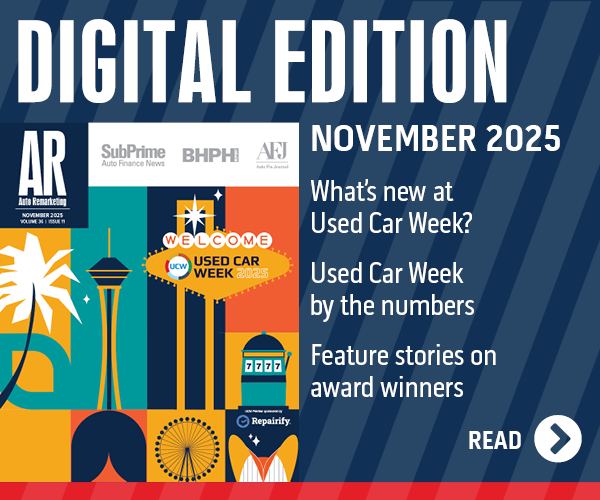Dealers, experts at NADA speak about used-car fundamentals for 2019

Action from the expo hall at NADA Show 2019. Photo courtesy of the National Automobile Dealers Association.
By subscribing, you agree to receive communications from Auto Remarketing and our partners in accordance with our Privacy Policy. We may share your information with select partners and sponsors who may contact you about their products and services. You may unsubscribe at any time.
SAN FRANCISCO –
If the months in front of us were an abstract painting, most auto dealers viewing it agree about what they see, with a few exceptions here and there.
To discover dealers’ concerns — and optimism — about the used-car business in 2019, I interviewed dealers, used-car consultants and auction executives before and during NADA Show 2019.
Rarely in these interviews did anyone use the noun “discipline” to describe an essential practice within their 2019 strategy; most talked about it though — sticking to the fundamentals. Those mentioned were inventory management, sourcing, getting cars front-line ready faster, improving used-car marketing and optimizing staff use of inventory management and other technology tools used in the dealership.
“We have a strategy to buy a different mix of cars, and we are sharpening our appraisals,” said Jason Church, general manager for Courtesy Volvo of Scottsdale, Ariz. “I think we also have to slow down that process. We have to let the consumer know transparently the vehicle they’re looking at is truly worth what you’re asking for it,” he said.
“And when you need to make that new-car sale, yes, you do sometimes put too much into that trade,” he said, “but then you need to manage it through the process efficiently and get rid of that problem as quickly as possible. The days of waiting for the problem to vanish off the lot are over. We must manage our problems quicker — that is the No. 1 focus!”
Used car operations consultant Tommy Gibbs agreed.
Subscribe to Auto Remarketing to stay informed and stay ahead.
By subscribing, you agree to receive communications from Auto Remarketing and our partners in accordance with our Privacy Policy. We may share your information with select partners and sponsors who may contact you about their products and services. You may unsubscribe at any time.
“Moving forward this year, people are going to have to have greater discipline than ever before; and when a certain used car is a mistake, acknowledge so. Identify those cars early — at 50 to 60 days in their lifecycle, you’ll be lucky to make anything on them,” Gibbs said. “You should have already found a retail buyer.”
John Napoleon is dealer principal for Carson Car Center Hyundai in Nevada. He sees the used-car market picking up, and he is focusing his used-car operation on increasing inventory turns, adjusting as needed to price fluctuation, balancing inventory mix to include 20 percent certified pre-owned vehicles and sourcing cars from an increasingly expanding reach.
“Dealers are really going to have to count on software tools as well, such as vAuto or one of its competitors, to really hone in on sharpening inventory practices, and that is what we’re doing,” Napoleon said.
Abdulla Abbadi is pre-owned manager at McGrath Arlington KIA, in Palatine, Ill. He acquires 60 percent of his inventory through auctions and the rest as trades. “Everything is online auctions,” he said.
He is stocking large SUVs and luxury makes — vehicles under warranty — to balance his used inventory.
The dealership sells 120 used cars a month now, but Abbadi is reaching to sell another 60 to 80 units a month.
“Like all dealers, we want to buy the best car for the money, and because we want to keep reconditioning costs down, that means we have to buy as clean a car as possible,” he said.
Napoleon agreed faster recon is a critical discipline. The faster a dealer can get cars from acquisition to the sales lot, the more opportunity a dealer creates to sell cars earlier in their prime retail window, he said.
David Simches is group used-car director for Crown Automotive Group in St. Petersburg, Fla., and is responsible for used-car inventory across the group’s 15 dealerships in three states. A 2019 initiative is to rally used-car marketing to make online vehicle page views stickier.
“Not only does a better online presence increase our credibility with customers but maximizes our results,” he said.
Simches also wants to add video clips to vehicle listings that show and explain to viewers how his dealerships’ reconditioning — showing before-and-after images — builds consumer confidence in his cars.
Also on his 2019 agenda is changing Crown stores’ appraisal focus so that trade appraisals factor in the value of downstream F&I and service income the new car — and resale of the trade — create.
Sourcing quality cars for their lots is a concern almost across the board.
“We’re more and more dependent on trading for inventory, because acquisition continues to be a problem,” said Ryan Johnson, general manager for Johnson Auto Plaza in Brighton, Colo. “The market still keeps moving towards trucks and SUVs, and there are not enough of them out there.
“We’re working deals to get those trades and obviously, the new-car market is tough, but the opportunity is to source those vehicles for the used-car lot. We’re using Manheim and Ally’s Smart Auction and having to source further and further out geographically,” Johnson said.
Church, of Courtesy Volvo, identified the opportunity to sharpen user skills for those who use sales and inventory management tools. He is also focusing on private-party acquisitions. Kelley Blue Book’s instant cash offer program helps him make more of these purchases.
Online auctions continue to take bigger bite out of physical auctions
At 4.2 million units, there will be 300,000 more lease returns in 2019 than there was in 2018, according to a recent analysis piece in Auto Remarketing by Anil Goyal of Black Book. Many of these cars will flow to dealers, who will purchase them for remarketing as certified pre-owned vehicles.
Manheim, a Cox Automotive brand, noted in Auto Remarketing late last year that for the first half of 2018 that 43 percent of all vehicles sold were to digital buyers using one of its digital platforms. Digital offsite sales, transactions happening outside a physical auction location, grew 39 percent over 2017, the company said.
Online auction ACV Auctions, which recently announced $93 million in funding to grow its business, is already selling 10,000 wholesale vehicles a month on its online auction platform. “It’s a 20-minute digital auction, so it is fast paced,” said chief executive officer George Chamoun at NADA while a live ACV auction played out on his smartphone. “Sold” alerts clicked off steadily as he talked.
“This auction shows 61 dealers bidding, and already we have 16 bids on this 2010 Mercedes with 100,000 miles. It’s a great car for one dealer; and for another, it’s not the car he or she wants,” Chamoun said.
ACV provides online bidders with a full vehicle condition report featuring 50 vehicle photos, including undercarriage and opened fluid reservoirs so buyers can observe any tale-tell signs of mechanical issues those systems’ fluids might be telegraphing.
Chamoun said these reports help dealers assess each vehicle’s estimated recon cost, which helps them evaluate a vehicle’s potential profitability. “For some, these cars are 98 percent close to (sale-ready),” he said.
Paul Lips, ADESA’s chief commercial officer, agreed that dealers buying at auction are more selective.
“They want to buy those vehicles that are front-line ready. Dealers want to get those cars to their lots in two to three days and then differentiate themselves with the right level of recon that translates into a better sales percentage,” he said.
As many dealers have pointed out, used cars aren’t necessarily scarce, but are not the kind of used cars franchised dealers want on their lots.
“Tell me a time in history when they were not,” said Gibbs, a consultant.
“That said, the alternative used-car businesses like Carvana and Texas Direct do disrupt the market,” Gibbs said. “The industry’s stress level will increase as more of these operators come on board — they have lower recon costs than franchised dealers, and they don’t add in packs as new-car dealers do.
“But that’s good news in my opinion,” Gibbs said. “When a CarMax goes into a market, dealers get nervous — but they also get better as a result!”
Crown Automotive Group’s Church agreed: “You know, we get used to things in this business, and when you get complacent you get slow. We need to be sharpening the saw all the time,” he said.


